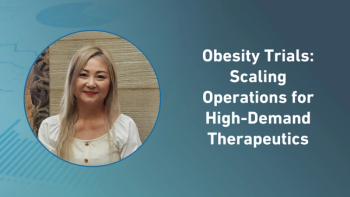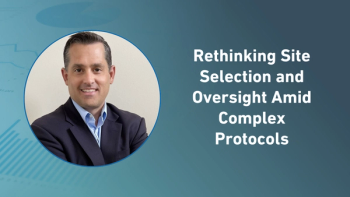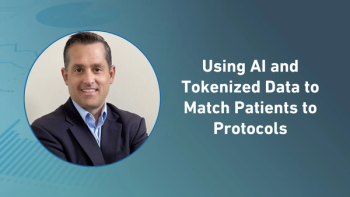
- Applied Clinical Trials-04-01-2003
EMEA Looks at Pediatrics?and EFGCP at Geriatrics
Pediatrics and geriatrics are the latest hot topics in the EU, so the CPMP is at least starting to help companies develop new clinical trials for children.
Work is going ahead on one of the new clinical trials areas taken on recently by the European Agency for the Evaluation of Medicinal Products. The Paediatric Expert Group (PEG), set up as part of the European Unions attempts to improve provision of medicines tested in children, has started to meet on a regular basis. And as a measure of how seriously the EMEA is taking its task, the group is chaired by Dr. Daniel Brasseur, the chairman of the EUs main human medicines scientific committee, the Committee on Proprietary Medicinal Products.
The topics under discussion range across the maturation of the immune system and consequences for the evaluation of medicines in children, the evaluation of medicinal products in neonates, and the possibility of assessing existing pediatric medicines by therapeutic class. It also generated some initial guidance for companies on the development of formulations of choice for the pediatric population in the EU, which was formally adopted during February.
This work on pediatric medicines is the direct outcome of efforts underway for over a year now. The goal is to fill the gap in clinical trials for the pediatric section of the population. In the background, discussions are still going on over the creation of new EU rules and an EU incentive scheme for companies to conduct specific clinical trials for children. The legislative work, however, is currently bogged down in the EU legislative machine. It is unlikely to produce anything with real impact until later this year or even 2005. In the meantime, the EMEA is trying to give some technical assistance and guidance to at least prepare the ground. It hopes to help direct company work into fruitful directions even before a regulatory system emerges.
Other EMEA clinical trials activities
Other innovative clinical trials discussions within the EMEA include some of the work being done by the new ad hoc expert group on gene therapy. Still setting up its mandate and rules of procedure, it has identified a number of areas for immediate studygonadal signaling, nonclinical and clinical models for germline integration, and insertional oncogenesis. Some of this work is to be taken forward this year in November, at the planned Tokyo meeting of the gene therapy group, which was set up within the framework of the International Conference on Harmonisation. As a further gesture toward ensuring medicines authorization and testing takes full account of subjects, the EMEA is also setting up a working group with patients associations in Europe. The official side will be represented by Dr. Frits Lekkerkerker, the Netherlands representative on the CPMP.
And in its growing role as an advisor to companies starting clinical trials programs, the CPMP delivered a series of responses to new requests from companies for assistance. The responses cover the clinical dossier for a biological product for treating multiple sclerosis, chemical products for treating psoriasis, or chemical products for prevention of organ rejection in transplantation. They also cover assistance on preclinical and clinical work on a biological for Parkinsons disease and chemical products for hyperlipidemias and for mania. They cover advice on developing the protocol for the preclinical and clinical testing for a chemical product for treatment of intestinal microsporidiosis. And they cover the protocol for the clinical testing of a biological for mucopolysaccharidosis (MPS II Hunter Syndrome).
A series of new guidance documents prepared by CPMP working parties and ad hoc groups has also been formally adopted by the CPMP. Some of these relate only tangentially to the clinical trials area (such as guidance on the chemistry of new active substances, on using excipients and antioxidants as antimicrobial preservatives, declarations on storage conditions, and declarations on the use of near infrared adopted spectroscopy by the pharmaceutical industry, and the data requirements for new submissions and variations using this technology). Others are right in the center of the clinical trials radar. These include a new concept paper on clinical investigation of medicinal products in neuropathic pain management, guidance on the methodology of clinical trials for the development of depot preparations of medicines in the treatment of schizophrenia, and on the development of live attenuated influenza vaccines. The CPMP also supports additional ICH guidance on clinical safety data management, concerning periodic safety update reports for marketed drugs.
The EMEA is also responding to the upcoming enlargement of the European Union, which in a years time will bring the EU 10 new member statesPoland, the Czech Republic, Hungary, Slovakia, Estonia, Latvia, Lithuania, Slovenia, Cyprus, and Malta. Already these acceding states are nominating the observers who will sit in on all EMEA meetings in the interim period between signing the EU Accession Treaty in April 2003 and formally entering the EU in May 2004. Given the wide range of clinical trials already being conducted in many of these new EU member states, the work of the EMEA and its committees is likely to have to take account of even more varied input into its discussions of clinical trials.
News to come on geriatrics
The big news in the background of EU clinical trials at the moment is the bid to bring the spotlight onto geriatric medicines. The European Forum for Good Clinical Practice recently took the initiative to organize a European conference on better healthcare for the elderly, which includes a strong clinical trials component.
This was something of a pioneer meeting, akin to the EFGCP activity on pediatric medicines two years ago that significantly contributed to raising the profile of that subject in Europe. As with the earlier EFGCP on pediatrics, there was no immediate direct consequence of this meeting on geriatrics. But EFGCP knows that getting topics onto the EU agenda is a slow and complex process. This first step will, EFGCP believes, pay off over time as momentum gathers behind the issue. The rapidly rising average age of the population in Europe (one dimension in which noone can find any argument with George W. Bushs recent remarks about old Europe) drives this issue as well.
As Dr. Roger Bickerstaffe, EFGCP chairman, explained to ACT, Ten years on from the creation of EFGCP, there is no longer any need to explain what good clinical practice is. Everyone now knows thatso any deficiencies now in GCP are the consequence either of ignorance or laziness.
According to the EFGCP chairman, this more sophisticated stage of general understanding of GCP means that the questions now no longer relate to the quality of the study, but to its focus. And in this new context, specific patient groups have started to receive more specific attention.
The first moves in this direction at EU level have been directed at testing of medicines for children. But there are good reasons for moving on to studies of medicines used in the elderly too. Its a question of healthcare generally and of medicines development in particular, he said. The approach is what Bickerstaffe describes as putting patients back at the centre.
Some of the participants at the meeting were cautious in their expectations of a rapid official response from the EU, because the subject still has low priority. It is only when the minister of health gets Alzheimers that well see some legislation, quipped one sardonic expert at the meeting. And even the greatest optimists there conceded that the earliest hope of any significant action at EU level appears to reside in the possibility that the Netherlands may try to get it onto the agenda next year, when they hold the rotating EU Presidency in the second half of 2004.
Nevertheless, the meeting set out clearly some of the background against which EU decisions could emerge. Jean-Marie Vetel, a leading French geriatrician, identified the need to create an effective definition concerning who geriatric care is for (given that an age cut-off date of 65 is quite inadequate), and the need to develop research into the terra incognita of medicine for the over-80s.
According to Christian Swine, of the Catholic University of Louvain in Belgium, The paradox of pharmacological therapy in older patients is undertreatment of frequent disorders or symptoms on the one hand, and the burden of polypharmacy on the other. In addition, he pointed out, there are few data to guide appropriate prescription for older people, because they are invariably under-represented in clinical trials. Swine urged a range of measureseducation for appropriate prescription and for improving compliance, technical improvements to make drugs packaging easier to handle and medicines easier to swallow, and better adaptation of dosages and drug combinations to the unique pharmacokinetics of the elderlyalso need further developments.
He also drew attention to the way that the lack of clinical data condemns the elderly to be in effect barred from receiving some of the medicines that would be most useful to them. Lack of data about the effects of medications in the population that uses them the most should receive greater emphasis, said Swine. Promotion of equal access to the major therapeutic advances that have been made in several domains is necessary, he said, pointing out that ACE inhibitors, beta-blockers, and other drugs in the treatment of congestive heart failure are still underprescribed, especially in the older patient. Due to their higher risk of cardiovascular morbidity and mortality, elderly benefit even more from appropriate treatments not only in chronic conditions but also in acute heart events, such as thrombolysis in acute myocardial infarction.
In the face of the growing demand for therapeutic approaches, arising from increasing life expectancy and increasing prevalence of age-related, chronic, disabling diseases, what is needed, claims Swine, is education of physicians on appropriate prescribing for the elderly (in terms of dosages, interactions, compliance), quality programs with quality control for undertreated or overtreated diseases or symptoms in the frail elderly, and, above all, full integration of clinical pharmacists into the multidisciplinary teams in the geriatric care network.
The analysis that emerged from the discussions between researchers, drug industry executives, and clinical trial professionals spelled out many of the problems. Many new medicines are not developed to address the specific concerns of the aging or of degenerative processes. Sometimes they are developed to address specific elderly patients (such as for Alzheimers disease) or obtain marketing authorization to meet specific requirements of an aging population (such as in hypertension, diabetes, and analgesics). But most new medicines are studied primarily, or only, in standard adult populationsusually for methodological, safety, and ethical reasons. Only a few go on to be studied in pediatric or other specific populations, including the aging.
At the end of the meeting EFGCP revealed its master-plan for moving the debate forwarda joint declaration by the interest groups that attended the conference. It urged a six-point plan for giving some substance to the expressions of good intention.
Principally, it said, European ethical and regulatory guidances for clinical research in aging persons should be prepared. Medicines should be developed to meet the therapeutic needs of an aging population. Those medicines should be developed, when appropriate, to meet the needs of an aging population in terms of specific dosage (including appropriate initial dose and dose regime), appropriate medicinal formulations, and appropriate instructions for use. Appropriate regulatory requirements for medicines that may be used in an aging population should be developed. And appropriate incentives for the development of medicines that meet the needs of an aging population, for both public and industry sponsored research, should be developed.
Even when the EU started work to boost trials for pediatric medicines, this column commented that many of the generation that are now children could not expect to see much of use emerging for them during their childhood. The same leisurely approach is likely to condition the EUs response to the rising awareness of the needs of the elderly. For many of them, the likelihood of remaining alive until they see any benefits from EU work is all the more limited.
Articles in this issue
over 22 years ago
Searching for a CRO - Can the Internet Help?over 22 years ago
Heading Off a Clinical Trial Liability Lawsuitover 22 years ago
Pediatric Subjects and Their Parents Respond to a Surveyover 22 years ago
Using Customer Relationship Management Strategiesover 22 years ago
Electronic Records, Pediatrics, and PROsover 22 years ago
Who's in Charge Here?over 1822 years ago
Maximize Information FlowNewsletter
Stay current in clinical research with Applied Clinical Trials, providing expert insights, regulatory updates, and practical strategies for successful clinical trial design and execution.




